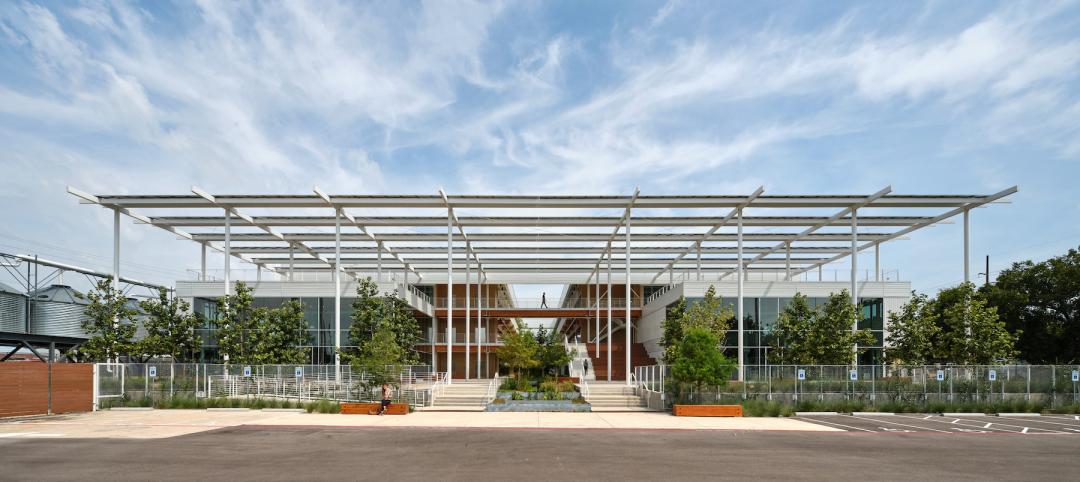Conventional windows have long been considered the weak link in the building envelope. According to the U.S. Department of Energy’s Building Technologies Program Multi-Year Program Plan 2011-2015, approximately 4.4 quadrillion Btu of energy in the U.S. is lost through windows in the form of heating and air-conditioning loads.
The DOE plan suggests that regardless of orientation or climate, window systems have the potential to outperform the best-insulated wall or roof in terms of annual energy performance, peak demand reduction, and cost.
UNIVERSITY FINDS A SOLUTION TO INEFFICIENT WINDOWS
The University of Minnesota’s Folwell Hall, a fixture on the National Register of Historic Places, recently underwent three years of extensive renovation.
Before the renovation, students, staff, and faculty who met in Folwell Hall were at the mercy of wildly fluctuating temperatures caused by outdated, inefficient windows, and an antiquated HVAC system.
The Building Team of Miller Dunwiddie Architects and construction manager McGough Construction, both of Minneapolis, set out to remedy this problem by replacing 400 existing windows with energy-efficient units. In order to meet state sustainability guidelines, window distributor National Window Associates Inc., Rogers, Minn., recommended Kolbe’s Ultra Series Sterling double-hung units with standard LoE2-270 double-pane insulating glass.
“Two of the main goals for Folwell Hall were to protect its historic significance and improve its energy efficiency,” says Denita Lemmon, AIA, project manager with Miller Dunwiddie. “The window system met both the aesthetic and performance specifications.”
In the 1980s, Folwell Hall’s century-old wood windows had been replaced with a basic aluminum system, which hid some of the historic architectural details. The replacement window system integrated aluminum-clad windows with custom aluminum panning to replicate the original architectural vision.
“To retain as much of the historical nature of the window openings, the interior trim was left in place,” says Tim Mahanna, project superintendent with McGough Construction.
The renovation of Folwell Hall was completed in August 2011. In addition to the new windows, the building’s HVAC system was updated to create an energy-efficient, temperature-controlled environment year-round. According to University of Minnesota officials, the indoor environment in Folwell Hall has been dramatically improved in terms of the HVAC, acoustics, and comfort.
COMMERCIAL RETROFIT KEEPS NOISE, ENERGY LOSS LOW
The 400 Market Street building in Philadelphia is an example of one of the countless buildings in the U.S. that are 30-60 years old where reglazing for aesthetic, environmental, or practical reasons is called for.
Constructed in 1972, the 12-story building is owned and managed by local property firm Kaiserman Co. As energy costs rose, along with tenant complaints regarding street noise, Kaiserman opted to install the Renovate by Berkowitz window retrofit system.
Glass fabricator J.E. Berkowitz manufactures an on-site window retrofit system that converts existing single-pane windows into energy-saving, triple-glazed insulating glass units. The retrofit system costs about 50% less than ripping out and replacing old windows.
Carolyn Pfeiffer, property manager of 400 Market Street, says the investment in the retrofit system is already paying dividends beyond cost and energy savings.
“Even without the energy savings, we’ve received positive feedback from our tenants, who are pleased with how much quieter and more comfortable the building is,” says Pfeiffer. The installation team worked with the tenants to minimize disruption to their workplace. “This not only made the tenants happy, but saved time and the cost of relocating them as well,” she says.
The retrofit took about 50 working days. In comparison, a traditional rip-out/replace project can take between 100-150 days for a similar 12-story structure.
AESTHETICS, THERMAL PERFORMANCE APPEAL TO MIDDLE SCHOOL
Beaty-Warren Middle School in Warren, Pa., recently completed an extensive renovation to update the 80-year-old facility. In addition to numerous structural and aesthetic updates, more than 300 high-performance, energy-efficient windows were installed.
Contractor Architectural Windows Concepts, Export, Pa., was given a six-month schedule to remove the existing windows and replace them with windows manufactured by Wausau Windows and Wall Systems.
Originally designed in 1930, the school experienced three building expansions to accommodate a growing student population. During each reconstruction phase, the windows were replaced on an as-needed basis, resulting is dissimilar styles and performance.
In 2010, the Warren County School District voted to replace the school’s windows and selected Hallgren, Restifo, Loop & Coughlin Architects, Erie, Pa., to design the reconstruction project.
“Our goal was to bring back the original intent and character of the building’s design,” says Chris Coughlin, lead architect. “We knew the windows would be an important piece to anchor the original design aesthetic and tie together the building’s many additions.”
Among the difficulties was creating profiles for more than 65 different window sizes and replicating the original shapes and colors of the window frames.
Mimicking the look of the school’s original windows, Wausau’s INvent Series units were fabricated for Beaty-Warren with a beveled face, muntin grids, and custom panning. Offset glass panes replicate the historic double-hung sash while offering easy operation, weatherability, and performance. The window’s triple-glazed, high thermal performance contributes to both the environmental and financial goals of the school. Following installation, interior temperatures at the school increased an average of 4-5 degrees Fahrenheit in the classrooms during the winter heating season. In the warmer months, the windows can be opened for natural ventilation.
To manage daylight, the windows were installed with one-inch, between-glass blinds. This allows staff to control glare, which may be evident on computer screens.
“Our office is very pleased with the design aesthetic,” says Coughlin. “The windows reflect the aesthetics that would be expected on a school from this particular era, yet add the performance we expect today.” +
Related Stories
Codes and Standards | Jul 22, 2022
Hurricane-resistant construction may be greatly undervalued
New research led by an MIT graduate student at the school’s Concrete Sustainability Hub suggests that the value of buildings constructed to resist wind damage in hurricanes may be significantly underestimated.
School Construction | Jul 22, 2022
School integrating conventional medicine with holistic principles blends building and landscape
Design of the new Alice L. Walton School of Medicine in Bentonville, Ark., aims to blend the building and landscape, creating connections with the surrounding woodlands and the Ozark Mountains.
Market Data | Jul 21, 2022
Architecture Billings Index continues to stabilize but remains healthy
Architecture firms reported increasing demand for design services in June, according to a new report today from The American Institute of Architects (AIA).
Market Data | Jul 21, 2022
Despite deteriorating economic conditions, nonresidential construction spending projected to increase through 2023
Construction spending on buildings is projected to increase just over nine percent this year and another six percent in 2023, according to a new report from the American Institute of Architects (AIA).
Mixed-Use | Jul 21, 2022
Former Los Angeles Macy’s store converted to mixed-use commercial space
Work to convert the former Westside Pavilion Macy's department store in West Los Angeles to a mixed-use commercial campus recently completed.
Building Team | Jul 20, 2022
San Francisco overtakes Tokyo as the world’s most expensive city for construction
San Francisco has overtaken Tokyo as the world’s most expensive city for construction, according to a new report from Turner & Townsend.
Libraries | Jul 20, 2022
Canada to open one of the world’s largest library and archive facilities
When it opens in 2026, Ādisōke is expected to be one of the largest library and archive facilities in the world.
Architects | Jul 19, 2022
Perkins Eastman Bolsters Its Dallas Studio with 5 Dynamic New Principals
Seasoned staff bring talent, experience, and enthusiasm to expand firm.
Energy-Efficient Design | Jul 19, 2022
All is not lost: 3 ways architects can respond to the Supreme Court’s EPA ruling
The U.S. Supreme Court’s ruling to limit the Environmental Protection Agency’s power to regulate greenhouse gas (GHG) emissions from power plants dealt a significant blow to our ability to fight the climate crisis with federal policy.
Office Buildings | Jul 19, 2022
Austin adaptive reuse project transforms warehouse site into indoor-outdoor creative office building
Fifth and Tillery, an adaptive reuse project, has revitalized a post-industrial site in East Austin, Texas.

















